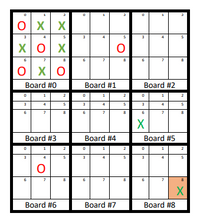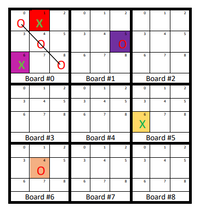
- Write up Java source codes for compiling and execution of program below.
- Draw UML diagram for codes.
There is a very simple solution to keeping Tic-tac-toe fresh and interesting, though, and it has been thought up by a group of mathematicians. It’s being called Ultimate Tic-tac-toe and simply embeds a Tic-tac-toe board in each of the nine squares of the original game.
Now instead of just winning the main board, you also need to win each of the smaller boards first until you have a line of three.
New Rule: You can only place a mark on the board determined by the position of your opponent’s last placed mark. So, if they put an X or O in the top right corner of a square, your next move must occur in the top right board.
By adding that rule the game is no longer about winning a single board, it’s about tactically managing up to 9 games at once and plotting ahead. You still win by marking three squares in a row, but that now involves winning three games.
The effects of the New Rule:
1: Your opponent can force you to choose an open square in an already won/tie board.
1- Player X Move:
- Board# : 0
- Square#: 1
2- Player O Move: Only valid Board is Board #1
- Square#: 5
3- Player X Move: Only valid Board is Board #5
- Square#: 6
4- Player O Move: Only valid Board is Board #6
- Square#: 4
For example, after a while Board # 0 has a winner, Player O. It is the Player X turn and the only valid Board# for Player X is Board#0
Player X Move: Only valid Board is Board #0
- Square#: 6
2: If the board is already full, you get a free pass to place your mark in any board
For example, after a while Board # 0 is completely full. It is the Player X turn and the only valid Board# for Player X is Board#0. Since Board#0 is full, then the Player X gets to pick any other Board.
Player X Move:
- Board# : 8
- Square#: 8
The great thing about this rule change and board layout is it remains easy to understand.
Basic Rules:
1. Each turn, you mark one of the small squares.
2. When you get three in a row on a small board, you’ve won that board.
3. To win the game, you need to win three small boards in a row.
4. You don’t get to pick which of the nine boards to play on. That’s determined by your opponent’s previous move. Whichever square he picks, that’s the board you must play in next. (And whichever square you pick will determine which board he plays on next.)
- Clarifying rules:
1. What if my opponent sends me to a board that’s already been won/tie but not full? In that case, you get to play on that board, but your move doesn’t affect the outcome of that board.
2. What if my opponent sends me to a board that’s already been full? In that case, congratulations – you get to go anywhere you like, on any of the other boards.
- Write up Java source codes for compiling and execution of program.
- Draw UML diagram for codes.


Trending nowThis is a popular solution!
Step by stepSolved in 2 steps with 1 images

- 9arrow_forwardProgramming language is C. I would really be appriciate if you could help me with this. Please provide me with your cashapp, so I can tip you for your work. THANK YOU:) In this project, we shall simulate the operations of an ATM machine. Suppose you’re in charge of this simulation and here is a scenario of what is required to do: The customer will be assigned a random or fixed number for his/her balance. First, the customer is prompted to enter his personal identification number pin (for this case study, we test only if this pin is formed by 4 digits! otherwise, a message like “Invalid PIN, try again . . .” will be displayed) and the user is re-prompted to enter the pin. The customer is given three chances to enter his pin. If he/she fails during the three trials you display a message like “Sorry you can’t continue, contact your bank for assistance!” If the pin is correct (formed by 4 digits), then the system will ask the customer for the receipt ( 1 for YES and 2 for NO ) and a menu…arrow_forwardUpdate Bresenham’s line (JAVA) method such that you can scale the line before drawing it. Normally, you pass two points and a Graphics’ object to draw line using Bresenham’s algorithm. Now you’ll add scaling factors in arguments for scaling as shown below. public void drawBresenhamLine(Point p1, Point p2, double Sx, double Sy, Graphics g) { //Write your code here } Note: If you use scaling method, then also write Scale method in solution. Answer:arrow_forward
- in Javaarrow_forwardCould you do this, please? I really need help on this. in Javaarrow_forwardTHIS IS MEANT TO BE IN JAVA. What we've learned so far is variables, loops, and we just started learning some array today. The assignment is to get an integer from input, and output that integer squared, ending with newline. But i've been given some instructions that are kind of confusing to me. Please explain why and please show what the end result is. Here are some extra things i've been told to do with the small amount of code i've already written... Type 2 in the input box, then run the program so I can note that the answer is 4 Type 3 in the input box instead, run, and note the output is 6. Change the output statement to output a newline: System.out.println(userNumSquared);. Type 2 in the input box Change the program to use * rather than +, and try running with input 2 (output is 4) and 3 (output is now 9, not 6 as before). This is what I have so far... import java.util.Scanner; public class NumSquared {public static void main(String[] args) {Scanner scnr = new…arrow_forward
- In Java, design a class that models a 6-sided die. The die will be used in a game. Simulate a roll of the die, return a random value from {1,2,3,4,5,6}.arrow_forwardWrite a FULL Java procedural program for one human player to play a “Higher or Lower” card game. In this game, each card has a value from 1..10 inclusive. There are 4 of each value in the deck, i.e., 40 cards in total. Cards are not replaced in the deck once drawn, i.e., no more than 4 of each value will be drawn. The program starts by asking the player for a target score. The game proceeds in a series of rounds with the program repeatedly drawing and showing a card from the deck to the player one at a time. Each time, it asks the player to enter "h" (higher) or "l" (lower) to guess whether the next card drawn will be higher or lower in value. The player gains a point if they guess correctly. The game continues until the player guesses incorrectly or the target score is reached. When the game ends, it prints either a "You win!" or a "Nice try, you scored …” message as illustrated below. The image provided shows two examples of the required program behaviour: (bold is keyboard input…arrow_forwardImplement the following in the .NET Console App. Write the Bus class. A Bus has a length, a color, and a number of wheels. a. Implement data fields using auto-implemented Properies b. Include 3 constructors: default, the one that receives the Bus length, color and a number of wheels as input (utilize the Properties) and the Constructor that takes the Bus number (an integer) as input.arrow_forward
- Using the Card.java class file, write a program to simulate a Deck of Cards. See Programming Project 8.7 (PP 8.7) from page 403 of your textbook (or view the attached image) for a description of what your program needs to do. Note that although the book description of the problem states that you should write the Card class, I do not want you to do that. You must use the Card file exactly as it is provided (NO modifications) and only write the DeckOfCards and Driver classes. public class Card{public final static int ACE = 1;public final static int TWO = 2;public final static int THREE = 3;public final static int FOUR = 4;public final static int FIVE = 5;public final static int SIX = 6;public final static int SEVEN = 7;public final static int EIGHT = 8;public final static int NINE = 9;public final static int TEN = 10;public final static int JACK = 11;public final static int QUEEN = 12;public final static int KING = 13; public final static int CLUBS = 1;public final static int DIAMONDS =…arrow_forwardWrite a method that takes two string parameters, and tells whether the first is a substring of the second. You can't use framework methods that do this for you, such as indexOf(). In other words, you have to write the loops yourself. But, you can use the primitive methods such as charAt(). Also analyze the program's performance and state the big-O complexity of your method. Provide a screenshot of the code working.arrow_forwardPlease help me solve this with java .... just the HangMan HangMan instruction class : • HangMan is a game in which a player tries to guess a word based on a given hint. For example, if the given hint is “movie”, then the player must guess a movie name. If the given hint is a “country”, then the player must guess a country name, and so on.• The game starts by showing a message on the screen that shows the hint and all letters in the word but obscured as dashes (-). Then, the game will allow the player to guess 5 letters. If the player gives a letter that actually exists in the word, then this letter will be revealed. Afterwards, the game will ask the player to give the answer. If the given answer is correct, then the game will show a message that the player has won 5 points. Otherwise, the game will show a message that the player has lost. Below is one possible game scenario, in which the word is “iron man”, and the hint is “movie”. Note that the text in green color is the…arrow_forward
 Database System ConceptsComputer ScienceISBN:9780078022159Author:Abraham Silberschatz Professor, Henry F. Korth, S. SudarshanPublisher:McGraw-Hill Education
Database System ConceptsComputer ScienceISBN:9780078022159Author:Abraham Silberschatz Professor, Henry F. Korth, S. SudarshanPublisher:McGraw-Hill Education Starting Out with Python (4th Edition)Computer ScienceISBN:9780134444321Author:Tony GaddisPublisher:PEARSON
Starting Out with Python (4th Edition)Computer ScienceISBN:9780134444321Author:Tony GaddisPublisher:PEARSON Digital Fundamentals (11th Edition)Computer ScienceISBN:9780132737968Author:Thomas L. FloydPublisher:PEARSON
Digital Fundamentals (11th Edition)Computer ScienceISBN:9780132737968Author:Thomas L. FloydPublisher:PEARSON C How to Program (8th Edition)Computer ScienceISBN:9780133976892Author:Paul J. Deitel, Harvey DeitelPublisher:PEARSON
C How to Program (8th Edition)Computer ScienceISBN:9780133976892Author:Paul J. Deitel, Harvey DeitelPublisher:PEARSON Database Systems: Design, Implementation, & Manag...Computer ScienceISBN:9781337627900Author:Carlos Coronel, Steven MorrisPublisher:Cengage Learning
Database Systems: Design, Implementation, & Manag...Computer ScienceISBN:9781337627900Author:Carlos Coronel, Steven MorrisPublisher:Cengage Learning Programmable Logic ControllersComputer ScienceISBN:9780073373843Author:Frank D. PetruzellaPublisher:McGraw-Hill Education
Programmable Logic ControllersComputer ScienceISBN:9780073373843Author:Frank D. PetruzellaPublisher:McGraw-Hill Education





